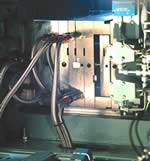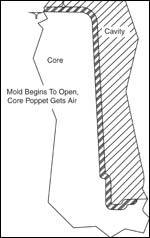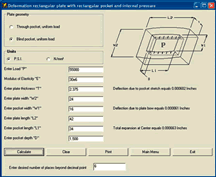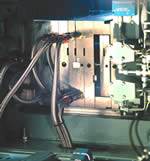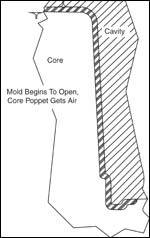Dispelling the Misunderstanding About Small Fittings
It is not always immediately obvious how much effect your choice of pipe tap and water-fitting sizes are having on mold performance.
Before anybody gets the wrong idea, I’m not suggesting that we all start designing our new molds around smaller fittings. Sometimes we might not be able to use the large fitting that we want to use. Sometimes we spend too much time and money designing around them because we think that mold performance will be significantly hampered by the use of small fittings. It’s not necessarily true, and I want to show you why, and what is important.
Let’s start closer to the beginning of our cooling system calculations. Fifteen years ago, I never heard anybody talk about the rate of fluid flow, and the corresponding Reynolds Number, with regard to molds. I studied it in college, but it seemed to be largely unknown in the moldmaking community. Today, because of trade publications, it has become quite well known. Regardless, a little review might be in order to establish the rest of my argument.
Reynolds Number
There are at least two reasons to calculate Reynolds Number during the course of designing a mold. This parameter is used to determine the type of flow that is occurring in a passage. Flow is classified as laminar, turbulent or transitional. A Reynolds Number (Re) of 2000 or less is generally accepted to indicate laminar flow. There are widely varying opinions of what Re is required to indicate turbulent flow in round passages. There is literature that claims turbulent flow will exist at a Re as low as 2600 or may need to be as high as 10,000. It is often accepted that a Re greater than 4000 is a good indicator of turbulent flow for water and oil in circular passages.
In the design of hydraulic circuits, it is desirable to keep the Re below 2000. Higher flow rates generate more resistance to flow, cause a mixing action and energy losses. The hydraulic oil temperature increases, which decreases the oil’s viscosity, which increases the Re even further. If the calculation shows the flow to be turbulent, or transitional, it is good practice to increase the hydraulic line size to ensure laminar flow in hydraulic systems.
As a form of visual description, it is often convenient to visualize water flowing from a faucet. During laminar flow, there is very little mixing action in the fluid. Laminar flow from a faucet appears clear or see-through. If you open the faucet until the flowing water appears white, you have turbulent flow. Transitional flow is the description for the types of flow that occur during the change from laminar to turbulent flow.
The mixing action that occurs during turbulent flow works to our advantage for mold cooling. It is critical to have turbulent flow in cooling passages in the mold. The heat transfer rate is proportionate—although in a non-linear fashion—to the Re. It is often accepted practice to design for a Re of 10,000 for mold cooling systems, although this is not always practical. I personally prefer to use a minimum of 6,000.
Formulas
There are several convenient formulas used to calculate Re, but they are all based on the following relationship:
Re = vDρ/µ
Where,
Re = Reynolds Number
v = fluid velocity
D = fluid passage diameter
ρ = fluid mass density
µ = fluid absolute viscosity
The other equations are used to compensate for the different units of measurement that may be known.
The equation that I typically use is:
Re = [(3160*Q) / (diameter in inches * viscosity in centistokes)]
Where Q = gallons per minute.
Table 1 below shows viscosity for water at various temperatures.
The Reason for Reynolds Number
Okay, you may be wondering why I brought up Reynolds Number. Well, there are a couple of reasons. First, it is important to design your cooling and hydraulic systems appropriately. Second, we will be using this during our pressure loss calculations.
Let’s move on to the pressure drop calculation, known as Darcy’s Equation.
Darcy’s Equation
This equation is used to calculate pressure losses in fluid system pipes and drilled passages.
Darcy’s equation is: (f * (L/D) * ((v^2) / 2g))
To calculate pressure loss in pounds per square inch, two additional factors are introduced as follows:
Pressure Losses = (f * (L/D) * ((v^2) / 2g)) * (.433 * Sg)
f = a friction factor
L = the length of the pipe or passage,
D = the diameter of the pipe or passage
v = the fluid velocity in feet per second
g = gravitational acceleration constant (32.2 ft per sec)^2
Sg = the specific gravity of the fluid, water is 1, for other fluids consult your literature or supplier
| Table 1 | |
| Temperature F° |
Viscosity in Centistokes |
| 32 | 1.79 |
| 40 | 1.54 |
| 50 | 1.31 |
| 60 | 1.12 |
| 70 | 0.98 |
| 80 | 0.86 |
| 90 | 0.76 |
| 100 | 0.69 |
| 120 | 0.56 |
| 140 | 0.47 |
| 160 | 0.40 |
| 180 | 0.35 |
| 200 | 0.31 |
| 212 | 0.28 |
| Viscosity for water at various temperatures. Table courtesy of DZynSource, LLC. | |
The .433 * Sg factor converts what would be called “head loss”, which is in units of feet, into pounds per square inch, since this is what we are usually interested in knowing. Since L/D is a ratio, the units are unimportant as long as the same units are used for both length and diameter.
The factor “f” (friction factor) can be found on charts available from hose and fitting suppliers, and in most fluid mechanics texts. These charts usually require you to be able to define the surface roughness in the passage. The one that is probably the most familiar to engineers is the Moody’s diagram. The problem for us is usually quantifying the surface roughness.
To work around this potential problem, there are two equations that are use to calculate the friction factor, which have been found to be appropriate for molds. The first, used for calculations involving turbulent flow in smooth passages with an Re less than 100,000, is called Blasius’ Law, and is as follows: f = .3164 / ((Re)^.25)
The second, used for laminar flow, is: f = 64 / Re
One more calculation is required. Darcy’s equation requires the fluid velocity, in feet per second, as input. Since we rarely know this, we must convert the quantity that we usually do know—which is usually flow rate in gallons per minute—into feet per second.
To calculate the area of our hole diameter, we use the familiar A = ((D ^ 2) * Pi) / 4
From there, the conversion from gallons per minute into feet per second is as follows:
v = (GPM * 231 in^3 / 60 seconds per minute / Area in inches^2 / 12)
GPM is gallons per minute. We use 231 because there are 231 cubic inches in a gallon. We divide by 60 to convert from minutes to seconds; the A is area of the hole diameter and converts cubic inches per second into inches per second, and the division by 12 converts inches per second into feet per second.
Finally, we have the tools required to be able to calculate the pressure drop through our fittings. We’ll do two sample calculations, one each for a .375 and .718" diameter holes, to compare the difference. For the sake of simplicity, I’ll keep the passage, or land, length at 1 inch for both sets of calculations.
For the .375 diameter hole, and using 6 gallons per minute of 60-degree water, we’ll calculate the Reynolds Number:
Re = (3160*Q) / [(diameter in inches)) * (viscosity in centistokes)]
Re = (3160*6) / (.375 * 1.12) = 45,142.8
Pressure Losses = (f * (L/D) * ((v^2) / 2g)) * (.433 * Sg)
f = .3164 / ((Re)^.25) = .0217
A= .375^2 * Pi/4 = .11045
v = (6 * 231 / 60 / .11045 / 12 ) = 17.43
Press.Loss = .0217*(1/.375)*[(17.43^2)/(2*32.2)]*(.433*1) = .118p.s.i.
For the .718 diameter hole, and using 6 gallons per minute of 60-degree water, we’ll calculate the Reynolds Number:
Re = (3160*Q) / [(diameter in inches)) * (viscosity in centistokes)]
Re = (3160*6) / (.718 * 1.12) = 23,577
Pressure Losses = (f * (L/D) * ((v^2) / 2g)) * (.433 * Sg)
f = .3164 / ((Re)^.25) = .0255
A= .718^2 * Pi/4 = .40489
v = (6 * 236 / 60 / .40489 / 12) = 4.75
Press.Loss=.0255*(1/.718)*[(4.75^2)/(2*32.2)]*(.433*1)=.0054p.s.i.
Now, on a percentage basis there is a huge difference, but on an absolute basis, you are not likely to notice any difference in mold performance by changing between these two fittings, in this situation.
Engineering Your Mold Design
A quick look at the equation shows us that the only non-linear relationship is the velocity, which gets squared; therefore, incremental increases in velocity will have a greater effect on pressure drop that any other factor. This is why it is so important to actually engineer your mold design. Let’s see what would happen if you used a fitting with a .125 diameter hole, and keep the passage length at 1 inch.
For the .125 diameter hole, and using 6 gallons per minute of 60-degree water, we’ll do the calculations:
Re = (3160*Q) / [(diameter in inches)) * (viscosity in centistokes)]
Re = (3160*6) / (.125 * 1.12) = 135,428
Pressure Losses = (f * (L/D) * ((v^2) / 2g)) * (.433 * Sg)
f = .3164 / ((Re)^.25) = .0165
A= .125^2 * Pi/4 = .01227
v = (6 * 231 / 60 / .01227 / 12) = 156.86
Press.Loss=.0165*(1/.125)*[(156.86^2)/(2*32.2)]*(.433*1)=21.829p.s.i.
Obviously, this is a large pressure drop, and not likely to be acceptable. Keep in mind that 6 gallons per minute will provide a Reynolds Number of 8200 in six .344 diameter water lines. This is assuming that you are using 60 degree water with no glycol added, so it’s not likely that you would ever end up in a situation where you would try to push 6 gallons per minute through a .125 diameter hole.
One very real problem with small fittings is that they are often used with small inside diameter hoses. Try running the calculations for 20 feet of small diameter hose. You may find that your largest pressure drops are outside the mold. If you need to use small fittings, be sure to reduce down at the end of the hose, and use as large a hose diameter as possible.
It can be a little time-consuming to run through all of these calculations manually, so it is best to either create a spreadsheet, or purchase a program, that will allow you to do “what if” scenarios quickly. Once this is programmed properly, the calculations can be done in a matter of seconds, or minutes, with less chance for errors.
Summary
The water fittings used on a mold are most often dictated by shop standards. If the molding department only has hoses with “300” or “500” series fittings, then that is what you will usually have to design around. If you are designing for a molder that has standardized on “200” series fittings, this may or may not be causing you problems. If you are the molder, make sure that the mold designer is actually doing the proper calculations.
The point of the article is this: it is not always immediately obvious how much effect your choice of pipe tap and water-fitting sizes are having on mold performance. If calculations can be done in minutes, or seconds, does it make any sense to skip over this critical step? You can make better decisions if you have more information. As always, over design can be expensive, and under design can be disastrous.
Related Content
It Starts With the Part: A Plastic Part Checklist Ensures Good Mold Design
All successful mold build projects start with examining the part to be molded to ensure it is moldable and will meet the customers' production objectives.
Read MoreMachine Hammer Peening Automates Mold Polishing
A polishing automation solution eliminates hand work, accelerates milling operations and controls surface geometries.
Read MoreHow to Eliminate Chatter
Here are techniques commonly used to combat chatter and guidelines to establish a foundation for optimizing the moldmaking process.
Read MoreRead Next
Putting More Engineering into Your Mold Design
How to choose the right software to assist you with engineering.
Read MoreDesigning the Mold: The Foundation for Success
The impact of different mold materials with regard to cooling; how to determine waterline placement for optimum cooling; placing cooling where heat is concentrated in the part; and, how to select a mold base sized for the machine being used.
Read MoreHow Tool Design Changes with the I.C.E. Process
Mold design will change as incremental cavity ejection is used in the molding process—which includes draft angles, finishes, undercuts, stresses, cycle time and quality.
Read More

